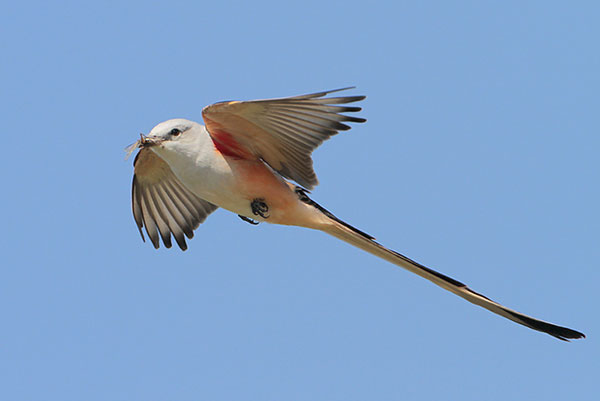The state bird of Oklahoma, with a breeding range encompassing only about one neighboring state in each direction, the Scissor-tailed Flycatcher’s pearly-gray plumage and spectacularly long tail give it an elegant appearance. The Scissor-tailed Flycatcher’s vocalizations and young are similar to those of its relative, the Western Kingbird.
Scissor-tailed Flycatcher nests are only rarely parasitized by the Brown-headed Cowbird, and Scissor-tails can remove cowbird eggs from their nests. Scissor-tailed Flycatchers gather in large flocks in late summer, prior to fall migration.
On this page
Identification of Scissor-Tailed Flycatcher
The Scissor-Tailed Flycatcher is a thrush-sized bird with a long, forked, black and white tail. Its head is mostly white with pale gray on the crown and nape, and it has white underparts with salmon pink on the sides, belly, and under the tail. The back is pale gray with a hint of reddish brown near the shoulder, and the blackish wings have feathers with frosty white edging. This elegant flycatcher also has a stout black bill, and black legs and feet.
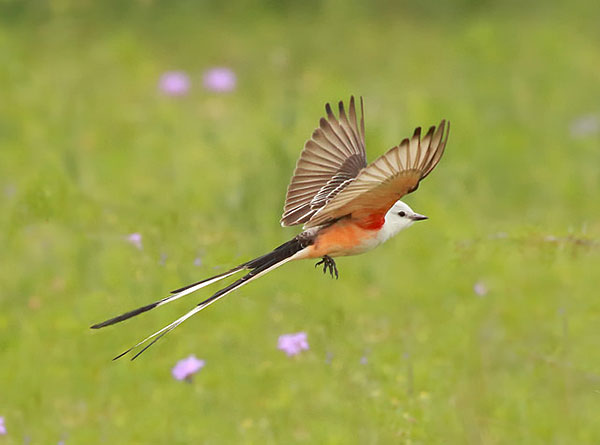
In direct flight, the underside of the long tail shows a prominent black tip but when the bird spreads its tail while hovering or flying after an insect, more white is visible. When the adult Scissor-Tailed Flycatcher spreads its wings, rich salmon red markings become noticeable where the wing meets the body and on the underwings. When excited, a small red patch is revealed on the crown.
Both sexes look alike although the male has slightly longer wings, beak, and tail (more than 10 inches in length whereas tails of females rarely reach 7 inches). Juveniles resemble adults but have shorter tails and muted colors on the underparts.
The Scissor-Tailed Flycatcher makes excited, pipping, sputtering calls.
Food
Scissor-Tailed Flycatchers eat large numbers of insects, especially grasshoppers, crickets, and beetles along with smaller numbers of bees, wasps, and other insects. They usually catch their insect prey by flying forth from a perch (often a fence post or wire), and snatching it from grass or other types of vegetation in open habitats like fields, prairies, and parks.
As with many other members of the tyrant-flycatcher family, the Scissor-Tailed also occasionally flies from a perch to catch insect prey in the air, and insects can be caught on the ground.
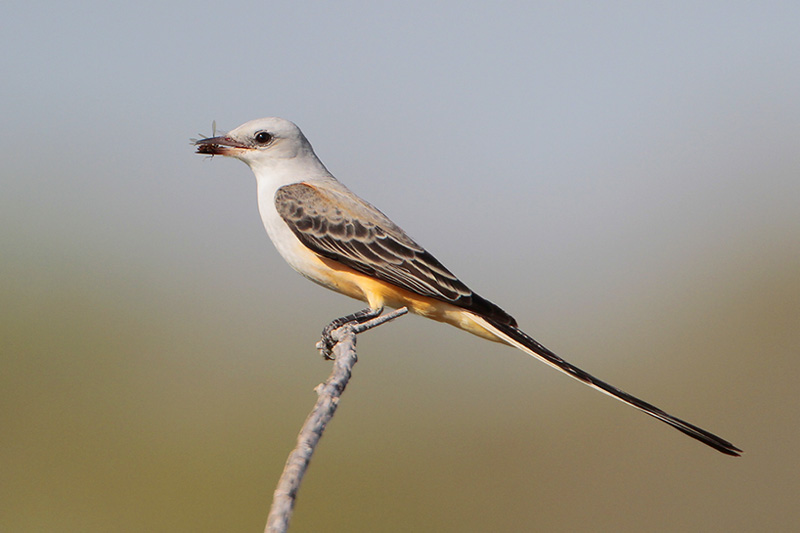
Photograph Greg Lavaty.
On account of insects being more active in warm weather, unlike many other bird species, the Scissor-Tailed Flycatcher forages more often during the mid-morning and late afternoon instead of feeding early in the morning. It also captures more insects in urban areas and when using fences and wires for perches as opposed to sallying forth from grass.
During migration and on their wintering grounds in Mexico and the Pacific coast of Central America, this species supplements its diet with berries and other small fruits. These are taken from fruiting trees while perched, or while briefly hovering or flying in to pick the fruit from the vegetation.
Nesting and Eggs
The female uses a variety of stems and other vegetation to construct the outer part of the nest, and pieces of cloth, cotton, feathers, and soft vegetation to build the core or inner part where the eggs are laid.
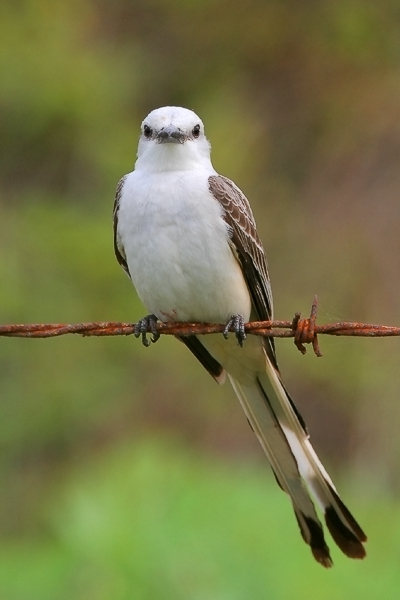
The Scissor-Tailed Flycatcher builds a cup-shaped nest in a lone, small tree or open shrub in large parks, big gardens, pasture, agricultural fields, chaparral, prairies, and other habitats with very few trees. Photograph Copyright Greg Lavaty.
The nest usually has a diameter of 4.7 inches, a height of 5.8 inches, and a depth of 1.6 inches. The nest can also be placed on a streetlamp, telephone pole, or other structure but is never built in areas with dense woodland.
This flycatcher species lays a clutch of four to five, white or cream-colored eggs with reddish or purple blotches on the larger end of the egg. One egg is laid per day and, on average, each one weighs 3.4 grams. Fewer eggs are laid in second clutches as well as in nests built later in the breeding season.
The eggs hatch after 14 days, both adults feed the young, and the baby birds start to fledge two weeks after hatching.
Current Situation
Scissor-Tailed Flycatchers live in a variety of open habitats from parts of southern Nebraska to southern Texas, east to Missouri, Arkansas, and Louisiana, and west to eastern New Mexico. Texas and Oklahoma form the core of their range; a region where they are especially common in savannah-like habitats punctuated by mesquite trees, and in different types of prairies.
Within their range, as long as isolated nesting trees and shrubs are available, these flycatchers can also live in parks, gardens, and other urban habitats. During the winter, they occur in similar open habitats and situations in western Mexico and Central America.
The species is considered to be common and is not endangered. However, populations in some areas have been declining, including in the core of their range. The reasons for the declines are unknown but may be related to clearing of brushland habitat needed for nesting and pesticide use that kills the insects they feed on.
Facts
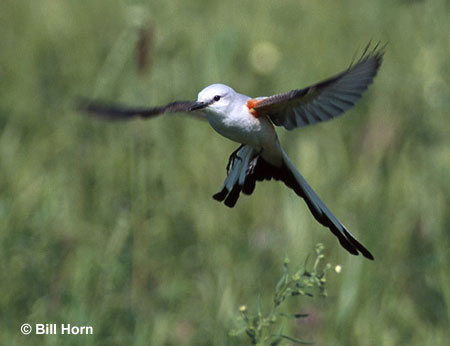
During courtship, male Scissor-Tailed Flycatchers fly high in the air and then glide back down, opening and closing their long tail while quickly moving back and forth.
- Like several other flycatcher species, the Scissor-Tailed has a bright red patch on top of its head. However, these scarlet feathers are normally hidden and only shown in aggressive situations where they defend their territory from other Scissor-Tailed Flycatchers or when defending their nest from hawks and other predators.
- When getting ready to migrate south, Scissor-Tailed Flycatchers can form huge flocks of a thousand or more birds. They often gather in towns that have large trees that can be used as safe roosting sites.
- During courtship, male Scissor-Tailed Flycatchers fly high in the air and then glide back down, opening and closing their long tail while quickly moving back and forth.
- Scissor-Tailed Flycatcher is the state bird of Oklahoma, a place where it is commonly seen perched on roadside wires, in parks, and in other open habitats. For this reason, the official quarter for the state features an image of this fancy bird.
Similar Species
With its unique pale coloration and eye-catching tail, very few species resemble the Scissor-Tailed Flycatcher.
- The Fork-Tailed Flycatcher has a similar long, streaming tail but is easily separated from the Scissor-Tailed by its darker back and black cap. This species is also a rare vagrant to North America.
- The Western Kingbird occurs in many of the same places as the Scissor-Tailed Flycatcher but has a much shorter, dark tail with white edges, and a yellow belly.
- The Couch’s Kingbird lives in southern Texas but uses more wooded habitats and has a shorter tail, gray head, and mostly yellow underparts.
FAQ
What is the range of the Scissor-Tailed Flycatcher?
The Scissor-Tailed Flycatcher breeds in much of Kansas, Oklahoma, and Texas, and in parts of adjacent states. It also breeds in northern Mexico and winters in southern Mexico and Central America.
Are Scissor-Tailed Flycatchers rare?
No, Scissor-Tailed Flycatchers are common and easily seen in much of their range.
How big is a Scissor-Tailed Flycatcher?
Scissor-Tailed Flycatchers are around the same size as a thrush. Without their long tail, they have a body length of 4.5 inches. Including the tail, the length of males is usually 13 inches and the length of the female is usually 10.5 inches.
Where can I see Scissor-Tailed Flycatchers?
Scissor-Tailed Flycatchers can be seen in parks, golf courses, pastures, brushlands, and a variety of other open habitats. They occur from parts of southern Nebraska to southern Texas, eastern New Mexico, and east to Missouri, Arkansas, and Louisiana. Some also winter in southern Florida but most winter in southern Mexico and Central America.

